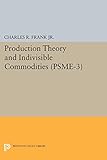Production Theory and Indivisible Commodities. (PSME-3), Volume 3 / Charles Raphael Frank.
Material type: TextSeries: Princeton Studies in Mathematical Economics ; 1886Publisher: Princeton, NJ : Princeton University Press, [2015]Copyright date: ©1969Description: 1 online resource (154 p.)Content type:
TextSeries: Princeton Studies in Mathematical Economics ; 1886Publisher: Princeton, NJ : Princeton University Press, [2015]Copyright date: ©1969Description: 1 online resource (154 p.)Content type: - 9780691622125
- 9781400875290
- 330.0151
- HB135
- online - DeGruyter
- Issued also in print.
| Item type | Current library | Call number | URL | Status | Notes | Barcode | |
|---|---|---|---|---|---|---|---|
 eBook
eBook
|
Biblioteca "Angelicum" Pont. Univ. S.Tommaso d'Aquino Nuvola online | online - DeGruyter (Browse shelf(Opens below)) | Online access | Not for loan (Accesso limitato) | Accesso per gli utenti autorizzati / Access for authorized users | (dgr)9781400875290 |
Frontmatter -- Preface -- Contents -- Chapter 1. Introduction -- Chapter 2. Production Possibilities, Attainability, Prices, Efficiency, and Profit Maximization -- Chapter 3. Indivisible Commodities and Returns to Scale -- Chapter 4. Substitution and Price Discrimination -- Chapter 5. Attaining Efficiency -- Chapter 6. Integer Activity Analysis -- Chapter 7. Conclusion -- Appendix -- Index
restricted access online access with authorization star
http://purl.org/coar/access_right/c_16ec
One of the usual assumptions in economic theory is that an entity called a commodity can be measured or that the amount of it can be represented by any real number. The functions (or other types of mapping) with which the economist deals, such as production functions, demand curves, and cost functions are assumed to be defined for real number arrays and to behave properly with respect to various criteria of continuity. Assumptions of this sort imply an acceptance of commodity divisibility. However, it is possible that in many instances indivisible rather than divisible commodities are the more relevant factors. This book incorporates the notion of indivisibility in a limited way into an analysis of production and allocation in the belief that there is a large class of problems for which this type of analysis is relevant.Originally published in 1969.The Princeton Legacy Library uses the latest print-on-demand technology to again make available previously out-of-print books from the distinguished backlist of Princeton University Press. These editions preserve the original texts of these important books while presenting them in durable paperback and hardcover editions. The goal of the Princeton Legacy Library is to vastly increase access to the rich scholarly heritage found in the thousands of books published by Princeton University Press since its founding in 1905.
Issued also in print.
Mode of access: Internet via World Wide Web.
In English.
Description based on online resource; title from PDF title page (publisher's Web site, viewed 30. Aug 2021)


